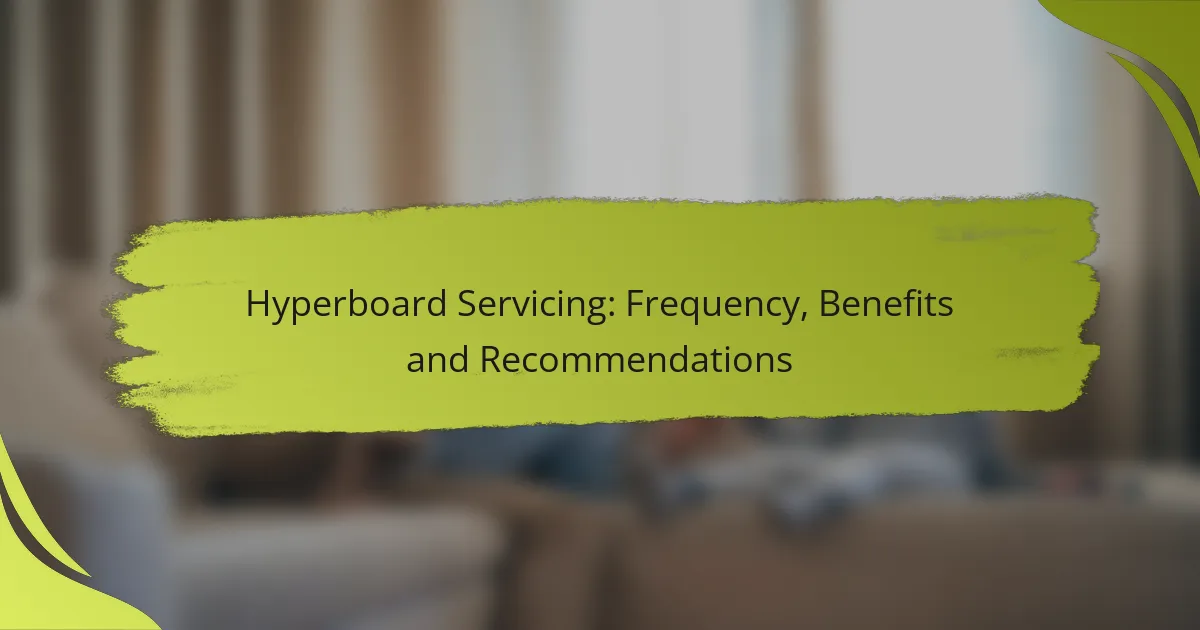Regular servicing of Hyperboards is crucial for maintaining optimal performance and safety, with recommendations suggesting a frequency of every six months. This proactive approach not only enhances the board’s functionality but also helps identify potential issues early, ultimately extending its lifespan and reducing repair costs.

How often should Hyperboards be serviced in the UK?
Hyperboards in the UK should generally be serviced every 6 months to ensure optimal performance and safety. Regular servicing helps identify potential issues early and maintain the board’s functionality.
Recommended frequency: every 6 months
Servicing Hyperboards every 6 months is a widely accepted practice that helps keep the equipment in top condition. This regular maintenance schedule allows for thorough inspections and necessary repairs, which can prevent more significant issues down the line.
During these biannual check-ups, technicians typically assess the battery, wiring, and mechanical components. Following this schedule can enhance the longevity and reliability of the Hyperboard.
Factors affecting service frequency
Several factors can influence how often Hyperboards should be serviced. Usage intensity is a primary consideration; boards used daily may require more frequent servicing compared to those used occasionally.
Environmental conditions also play a role. Boards exposed to harsh weather or rough terrains may need servicing sooner due to increased wear and tear. Additionally, any modifications or upgrades made to the board can affect its maintenance needs.
Signs that servicing is needed sooner
There are specific indicators that suggest a Hyperboard may need servicing before the scheduled 6 months. Unusual noises, decreased battery performance, or difficulty in steering are all signs that something may be wrong.
If the board shows signs of physical damage or if the lights indicate a malfunction, immediate servicing is recommended. Addressing these issues promptly can prevent further damage and ensure safe operation.

What are the benefits of regular Hyperboard servicing?
Regular servicing of Hyperboards offers significant advantages, including enhanced performance, improved safety, and potential cost savings on repairs. By maintaining your Hyperboard, you ensure it operates efficiently and safely, extending its lifespan and reducing the likelihood of unexpected issues.
Improved performance and longevity
Regular servicing helps maintain optimal performance by ensuring all components are functioning correctly. This includes checking the battery, motors, and wheels, which can degrade over time. A well-maintained Hyperboard can last several years longer than one that is neglected.
Routine checks can identify minor issues before they escalate into major problems, allowing for timely repairs. This proactive approach not only enhances performance but also contributes to a smoother ride and better handling.
Enhanced safety features
Safety is paramount when using a Hyperboard, and regular servicing plays a crucial role in ensuring all safety features are operational. This includes inspecting brakes, lights, and stability mechanisms to prevent accidents. A Hyperboard that is regularly checked is less likely to malfunction unexpectedly.
Additionally, servicing can help keep the Hyperboard compliant with safety regulations, which can vary by region. Staying informed about local laws and ensuring your device meets these standards can prevent legal issues and enhance rider safety.
Cost savings on repairs
Investing in regular servicing can lead to significant cost savings over time. By addressing minor repairs during routine maintenance, you can avoid more extensive and expensive repairs later. For instance, replacing worn-out parts early can prevent damage to other components.
Moreover, many service providers offer maintenance packages that can be more economical than paying for individual repairs. This proactive approach can help you budget effectively for Hyperboard upkeep, ultimately saving you money in the long run.

What are the recommended servicing procedures for Hyperboards?
Regular servicing of Hyperboards is essential for optimal performance and safety. Recommended procedures include inspecting electrical components, maintaining the battery, and evaluating the wheel and brake systems.
Inspection of electrical components
Inspecting electrical components is crucial for ensuring the safe operation of Hyperboards. Check for loose connections, damaged wires, and signs of corrosion. Regular inspections can help prevent electrical failures that could lead to accidents.
Perform these inspections at least every few months or more frequently if the board is used heavily. Look for any unusual sounds or smells during operation, as these can indicate underlying issues.
Battery maintenance and checks
Battery maintenance is vital for extending the lifespan of Hyperboards. Regularly check the battery’s charge level and ensure it is properly connected. Avoid letting the battery drain completely, as this can lead to reduced performance over time.
Consider charging the battery after each use and storing it in a cool, dry place. If the battery shows signs of swelling or leakage, it should be replaced immediately to prevent safety hazards.
Wheel and brake system evaluation
Evaluating the wheel and brake systems is essential for safe riding. Inspect the wheels for wear and tear, ensuring they are free from debris and properly inflated. Check the brake pads for sufficient thickness and responsiveness.
Perform these evaluations monthly or before long rides. If you notice any unusual vibrations or decreased braking performance, address these issues promptly to maintain safety and control while riding.

What should you consider when choosing a Hyperboard servicing provider?
When selecting a Hyperboard servicing provider, prioritize their experience, customer feedback, and the guarantees they offer. These factors will help ensure you receive reliable and effective maintenance for your Hyperboard.
Experience and certifications
Look for providers with extensive experience in servicing Hyperboards, as this often correlates with a deeper understanding of the technology and common issues. Certifications from recognized industry bodies can further validate their expertise and adherence to best practices.
Consider asking potential providers about their years in business and the types of Hyperboards they have serviced. A provider with a diverse portfolio may be better equipped to handle various models and issues.
Customer reviews and testimonials
Customer reviews and testimonials provide insight into a provider’s reliability and quality of service. Check online platforms and forums for feedback from previous clients to gauge satisfaction levels.
Look for patterns in reviews, such as consistent praise for timely service or effective problem resolution. A provider with a strong track record of positive feedback is likely to deliver a better experience.
Service guarantees and warranties
Service guarantees and warranties are crucial when choosing a Hyperboard servicing provider. A reputable provider should offer clear guarantees on their work, ensuring that any issues arising post-service will be addressed without additional costs.
Inquire about the specifics of their warranties, including duration and coverage. A solid warranty can provide peace of mind and protect your investment in the Hyperboard.

What are the costs associated with Hyperboard servicing in the UK?
The costs for Hyperboard servicing in the UK can vary widely based on several factors, including the type of service required and the provider. Generally, customers can expect to pay anywhere from £50 to £150 for standard maintenance and repairs.
Average service costs
On average, routine servicing for a Hyperboard typically ranges from £60 to £100. This may include basic maintenance checks and minor repairs. More extensive repairs or specialized services can increase costs, sometimes exceeding £150.
Factors influencing pricing
Several factors can influence the pricing of Hyperboard servicing. The complexity of the issue, the specific parts needed, and the technician’s expertise all play a role. Additionally, geographical location within the UK can affect service rates, with urban areas often charging more than rural locations.
Potential discounts for regular customers
Many service providers offer discounts for regular customers or those who sign up for maintenance plans. These discounts can range from 10% to 20% off standard rates, making it more economical for frequent users. It’s advisable to inquire about loyalty programs or package deals when seeking servicing options.

What are the common issues identified during Hyperboard servicing?
Common issues identified during Hyperboard servicing include hardware malfunctions, software glitches, and connectivity problems. Addressing these issues promptly ensures optimal performance and longevity of the Hyperboard system.
Hardware Malfunctions
Hardware malfunctions can manifest as unresponsive screens, faulty sensors, or power failures. Regular checks can help identify these problems early, preventing more significant disruptions.
Common signs of hardware issues include unusual noises, overheating, or failure to power on. It’s advisable to conduct routine inspections every few months to catch these problems before they escalate.
Software Glitches
Software glitches often result in slow performance or unexpected crashes. Keeping the software updated is crucial for minimizing these issues and ensuring compatibility with new features.
To mitigate software-related problems, regularly clear cache and temporary files. Implementing a schedule for software updates can help maintain system stability and performance.
Connectivity Problems
Connectivity problems can hinder the Hyperboard’s ability to communicate with other devices or networks. These issues may arise from outdated firmware or network configuration errors.
To resolve connectivity issues, check network settings and ensure that all devices are on the same network. Regularly updating firmware can also prevent potential connectivity disruptions.
